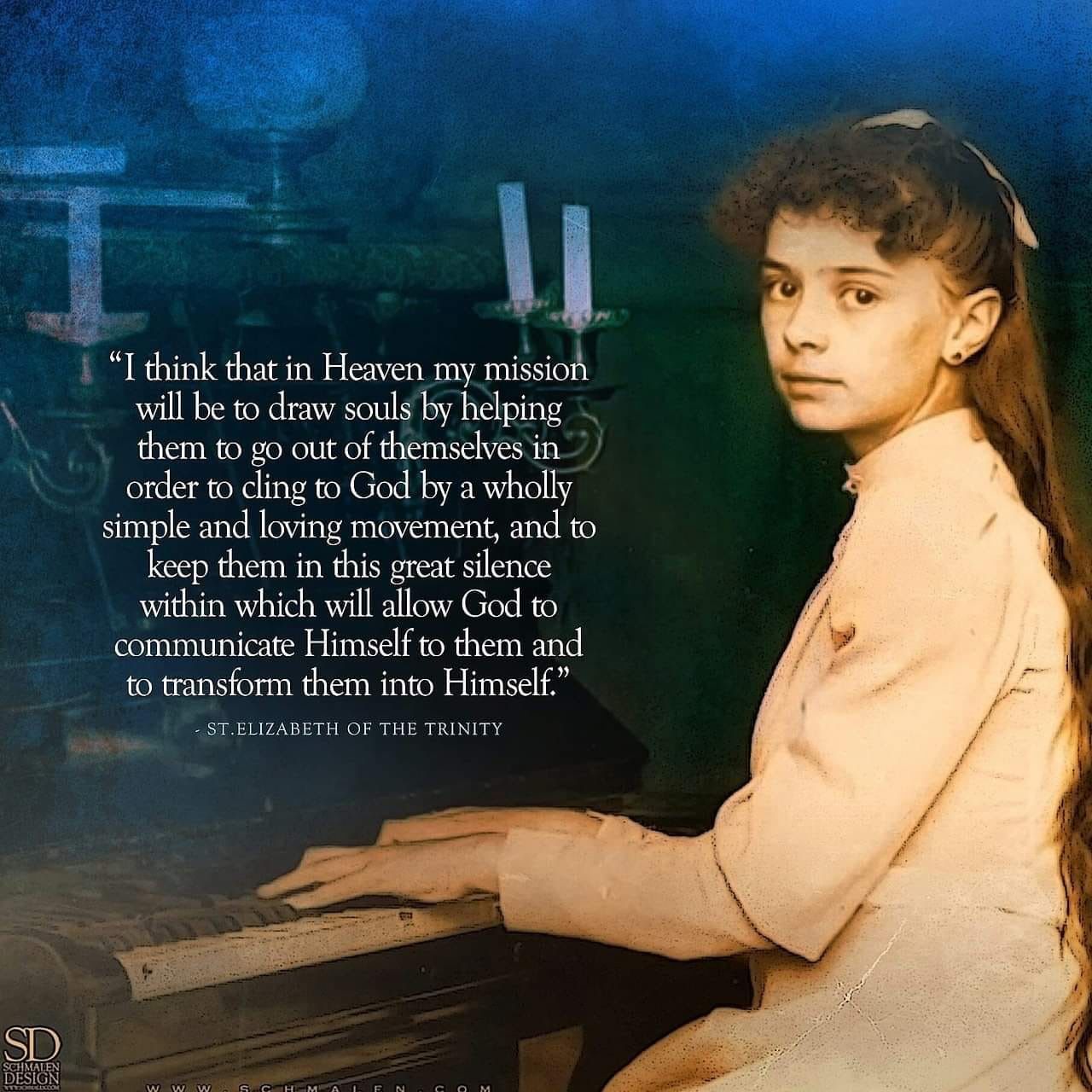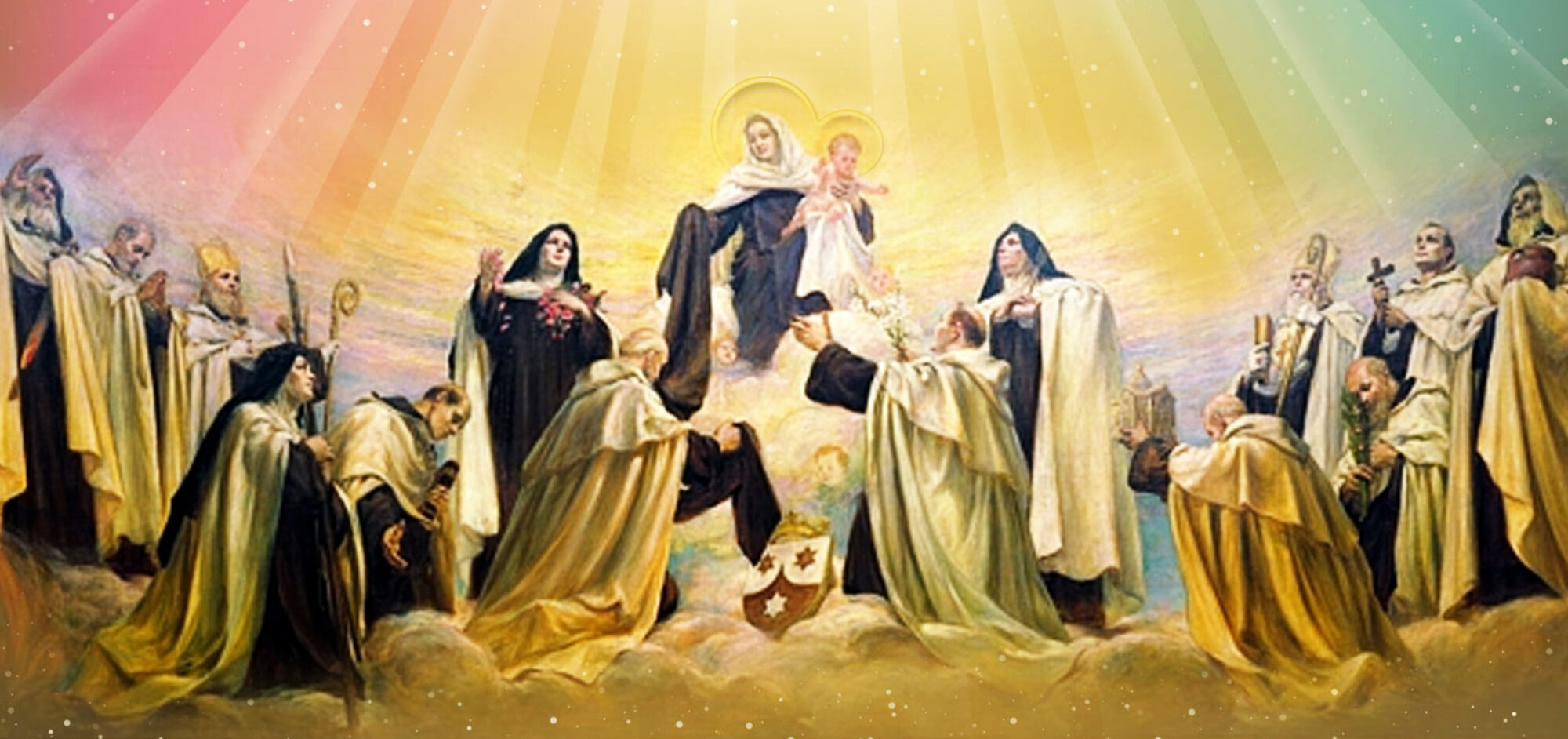SAINT ELIZABETH OF THE TRINITY, OCD (1880-1906)

INDEX
- The Fury and Glory of St. Elizabeth of the Trinity
- St. Elizabeth of the Trinity: Lessons on Living in the Heart of the Church
- How St. Elizabeth of the Trinity taught me how to pray for others in 7 words
THE FURY AND GLORY OF ST. ELIZABETH OF THE TRINITY
by Elizabeth Scalia (wordonfire.org)
Born in the Septaine district of France, she was the eldest of two daughters. Upon the sudden death of her father, the girls and their mother moved into to a second-story apartment that overlooked the Carmel of Dijon.
Her name was Elizabeth Catez, and her family’s fond nickname for her was not Lizzie or Beth, but Sabeth. In her childhood, she was regarded as a brilliant pianist and a very good student overall. She would have been a most delightful child, in fact, were it not for an instinctive stubbornness, a naturally noisy nature, and a fiery temper. Although she eventually became a Sister-in-Carmel to St. Thérèse of Lisieux, a comparison of their early biographies would never suggest it, because Sabeth was what one might kindly call a little ball of fury. So disruptive, obstreperous, and bossy was she—another nickname given her was “The Little Captain”—that her harassed mother declared her intention to send her daughter to a “School for Corrections” run by the Good Shepherd Sisters, and went so far as to pack her daughter’s bags with her own hands.
The threat worked. Elizabeth apologized and made sincere—and repeated—efforts to gain some control over her temper and her high spirits. She received her First Holy Communion at age eleven, and on that very day made her first visit to the Dijon Carmel, where the Prioress informed her that her Christian name meant “House of God.”
She was much struck by that information and resolved that the possession of so beautiful a name could not help but inspire her toward living a more godly and disciplined life. Since she had been named as a House of God, perhaps it was what she was meant to be, Elizabeth reasoned, and a House of God could have no standing with an agent of mischief and chaos in residence.
The idea helped. A little. Enough so that she began to think she might eventually be called to a life lived for Christ alone, perhaps even in Carmel. Still, her youthful spirituality lived uneasily with her nature, developing in fits and starts. After confessing one especially loud and extended temper tantrum to her parish priest, he declared that she would either die a saint or a demon—there could be no other possibilities.
“A soul united to Jesus is a living smile that radiates Him and gives Him.”
Heading into adolescence, Elizabeth decided to work for sainthood over the alternative, but she did it lightly. “By my nature, I am a coquette,” she once wrote for a school assignment. “I am by no means a model of patience, but I have learned to control myself, and I do not hold grudges.”
For a time, she lived as a bit of a coquette too. Elizabeth socialized, crafting lovely dresses, creating hair designs, and traveling with her family, all of which assuaged her mother’s deep fear that the cloister walls a mere 650 feet from their apartment would eventually seal her daughter away from her. So disapproving was Madame Catez of that notion that she begged Elizabeth to put aside all ideas of religious life, at least until her twenty-first birthday. After all, she reasoned, men of means and good character were offering marriage to Elizabeth. If she delayed her entry, perhaps one of them would reach her heart.
That would not happen. Even as she enjoyed parties and participated in musical galas, Elizabeth’s turn toward Carmel progressed. She began to practice contemplative prayer, which greatly helped to tamp down her temper, although her irrepressible nature would still break through. Consulting with a Carmelite chaplain as to whether she did in fact have a vocation, Elizabeth found herself tapping her toes, waiting for him to stop talking as his long-winded approval went on and on. “I just wanted him to confirm I was on the right track,” she groused.
Her mother watched as her daughter continued to meet with the prioress and spent a great deal of time at the parish giving catechism lessons to children and adults. As her twenty-first birthday loomed, Elizabeth’s mother knew her defeat was coming.
“Prayer is a rest, a relaxation. . . . We must look at him all the time; we must keep silent, it is so simple.”
When it came, Elizabeth—with courtesy and real compassion for her mother’s pain—insisted she be permitted to live the life she was called to; in August of 1901, two weeks after turning twenty-one, she claimed her birthday present, walking into Carmel with her mother and her sister and then bidding them a loving adieu as she passed into the cloister.
There Elizabeth, like Thérèse before her, burned through Carmel like a bottle rocket, riding twin fuses of suffering and abandonment to the divine will. She soared—disappearing into Christ as “Laudem Gloriae,” the praise of his glory.
She lived only five years after entering Carmel, succumbing to the ravages of Addison’s Disease at age twenty-six, but she clearly made the most of her time there, advancing in wisdom and becoming an astounding teacher of the ways of love through her published letters.
St. Elizabeth of the Trinity: Lessons on Living in the Heart of the Church
by CARDINAL ANDERS ARBORELIUS, OCD
As her name indicates, St. Elizabeth of the Trinity was totally immersed in contemplation of the triune God Who lived in her through Baptism. She knew that the ultimate foundation of human love and friendship is always the unity of love reigning within the Trinity. As a reflection of God Himself, the friendship between human beings becomes a redemptive reality in the Church. The Church is the context, the atmosphere, where we live in a kind of Trinitarian friendship. God is always present among the members of the Church, binding them together just as the three Divine Persons are bound together.
Elizabeth described her friendship with another sister, “The mystery of the Three has been reproduced on earth since our two hearts have found their union in Yours.” The Church is the communion of saints in which the Most Holy Trinity is always present as the heart of the ecclesial mystery. The Church always reflects the Trinity, and inter-ecclesial solidarity has its foundation in intra-trinitarian communion. This majestic truth of our Faith becomes a day-to-day reality in the life of Carmel, where Elizabeth tried to live in constant union with the Trinity, and at the same time, with her sisters.
Although she lived totally hidden away from the outside world, it is quite evident through her many letters that she had friendly relationships with many people outside Carmel. These letters are often masterpieces of concrete spiritual direction for laypeople. Her spiritual doctrine is very much suited for people living in the midst of society. And in this way, her ecclesial mission becomes evident. She was aware that all the members of the Church, whether in peaceful enclosures or busy in society, are united in adoration of the Trinity, helping each other in the fulfillment of this important task. Through adoration, they become brothers and sisters in the communion of saints. In the act of adoration, they enter into an invisible unity with each other, and this day-to-day reality brings forth many hidden fruits.
This vision of spiritual solidarity emphasized by Elizabeth can be very helpful for so many people feeling isolated and alone, suffering from this twofold disease that is, alas, so common today. If people came to the realization that they really belong to this communion of saints, things would change dramatically.
Elizabeth made a spiritual synthesis that reflects her vision of her own vocation. She uses the Latin words laudem gloria, from St. Paul, in order to characterize this vocation of hers. She is “called to give praise and glory to God whatever she is doing, however she is feeling.” Here on earth, Elizabeth had already begun doing what she was meant to do in eternity — glorify God. She knew that she was never on her own, but always united with all believers, on earth, in Heaven, and in Purgatory.
The Church is one and the same in its different stages. As Bride of the Lamb, She is always adoring and glorifying the Most Holy Trinity. With the simple eyes of faith, Elizabeth contemplates the entire mystery of the Church, which has its beginning in the bosom of the Trinity long before the creation of the world and which one day will find its fulfillment there, too.
In Elizabeth’s writings, the notion of predestination is quite common. We might even say that Elizabeth is the Catholic answer to Calvin. In contrast to his individualistic outlook, she looks upon predestination mainly as the predestination of the entire ecclesial body to take part in God’s eternal glory. Every person is called upon to enter into communion with the Church, being transformed by grace and finally receiving eternal glory through the merits of the redemptive love of Christ. Predestination is a mystery of immense love.
In a posthumous note, Elizabeth of the Trinity wrote, “I bequeath to you this vocation which was mine in the bosom of the Church Militant and which I shall fulfill henceforth unceasingly in the Church Triumphant: a praise of glory of the Blessed Trinity.” This spiritual heritage of hers is a very pedagogical, or rather mystagogical, approach to the entire reality of the Church. We can never separate the Church from the Trinity. In her bosom, we can live as friends adoring God, giving praise to Him and, thus, growing in mutual love and help. This intra-ecclesial friendship is also an important point of evangelization, as we know from the early Church. “Friendship with any man is ultimately friendship with Christ,” William Johnston said.
Mother and Bride
The Church is more Mother than institution, more Bride than hierarchy, more mystery than sociology. The Carmelite vision of the Church concentrates on this innermost reality of the Church. This reality can help those who often feel utterly alone and empty, to find healing in the life-giving womb of the Church.
Jesus will always care for His bride, whether she be the Church or the soul. Human beings are always the same. They were created by God’s love and for His love. If they can discover the Church as the fruitful ambiance where they can inhale God’s love and be transformed by it, then they will feel at home in Her. The Carmelite saints have an extraordinary capacity to point to essentials. When they speak about the Church, they always do so in a tone of prayer and adoration of the triune God. The Church is a reflection of the intra-trinitarian love between the divine Persons.
Consequently, the Church will always bring us closer to God. The Carmelite mystics can help our brothers and sisters who are formed and shaped by the modern malaise of individualism to rediscover the true face of the Church.
The Carmelite doctrine stressing these theological virtues is a remedy against this disease of our times. The Church is the concrete brotherhood — and sisterhood — in which we help each other to live according to the theological virtues. The Carmelite saints are our helpful brothers and sisters on this mystical path. The contemplative ecclesiology of Carmel can also be a remedy against the malaise that so many of our contemporaries feel in regard to the Church and Her many weaknesses.
The Church of today needs a kind of spiritual plastic surgery in order to rediscover Her true heart and regain the true beauty of Her face. Our Carmelite tradition can help her in this ongoing process of conversion, in order that She may realize that, through Her wounds, She is even closer to her Bridegroom and His redemptive love. “His heart is an open wound with love,” St. John of the Cross said. And so we, too, in our lives in the Church can receive Christ’s redemptive love. We can live in His presence. We can receive His grace. And we can become more and more the Church as it is meant to be, because as we see in the Carmelite mystical tradition, the Bride of Christ is the Church, it is Mary, and it’s each one of us. And within the Church we receive our true being. We can become saints in the heart of the Church, but we have to live in Her very heart, in constant prayer and adoration of the Blessed Trinity.
This article is adapted from a chapter in Cardinal Arborelius’s book, Carmelite Spirituality: The Way of Carmelite Prayer and Contemplation.
How St. Elizabeth of the Trinity taught me how to pray for others in 7 words
by Elizabeth Scalia (aleteia.org)
I can tell you that it was in 2003 that I learned a new, and highly instructive, efficacious way to pray for the sick. That was the year I purchased Volume 2 of the Letters from Carmel from Elizabeth of the Trinity.
It was one of those books I couldn’t put down and when I finished it I felt like I’d had a personal, one-on-one tutorial on the subject of love: How to give it unstintingly, how to get more of it (see giving, unstintingly), because the more love you give, the more you get. Like an oil jar that never empties.
The tutorial included a lesson in prayer that I took deeply to heart as well, for as I read it became apparent that whenever Elizabeth was asked for prayers, she would immediately reach into scripture, and place herself with Martha and Mary, the beloved sisters of Lazarus who lived in Bethany. With them, she would petition Christ, beginning, “Lord, the one you love is sick…”
How often had I read those words in scripture, or heard them of a Sunday’s Gospel reading, and passed them by, assuming that they were simply a reporter’s narrative — the words meant only for Lazarus, and provided to just move the story along.
But Elizabeth of the Trinity knew what I’ve too frequently forgotten: That every line of scripture is there for a purpose; none of it is accidental; none of it is meant to be passed over, sloughed off, or be left unconsidered, because together all of the lines give us the theology through which we come to better understanding, growth, increased nearness to Christ.
And so Elizabeth doesn’t pass over the lines; instead she sees their instruction and example — their promise of powerful effect.
The instruction comes from the insight: the person for whom we intercede is very much, every day and unquestionably, “the one Christ loves,” the indispensable individual unlike any other, whom Christ loves.
The power comes from acknowledging that unconditional love, and claiming it with calm assurance and an expectation that Christ Jesus will neither deny nor ignore it. He cannot because he is Truth, and his love is true, too.
“Lord, the one you love is sick…”
When Mary and Martha sent these words to Jesus, he lingered where he was. He did not immediately heal his friend, because he was communicating the constant message of his own Crucifixion: that suffering — which none of us escapes in this world — is a component, perhaps a triggering component, of Glory, which comes with myriad answers and consolations. The glory is promised us, and the saints all tell it, if we only trust: All of God’s purposes are to the good; although we may not always understand this we can trust in it. (St. Philip Neri). When Mary and Martha ran to Jesus, they were anxious, yet full of trust. “Lord, the one you love is sick…”
My petitions sometimes seem endless, as though I am haranguing God: “Lord, the one you love is sick,” I will pray, or “Lord, the one you love is lonely,” or “Lord, the ones you love are enslaved by rage and hate.”
“Lord, the one you love is anxious…”
“Lord, the one you love is in danger…”
“Lord, the one you love is unemployed and feels rejected…”
“Lord, the one you love needs you…”
I cannot tell you how many times I have uttered some variation of these words at the start of a petition for a friend, and have later heard that at precisely that moment, there was an easement of suffering and anxiety. Perhaps healing did not come, but something of Christ did. “I felt it,” friends would say. “Suddenly, my wife said she felt upheld and comforted…”
And then I think, “Yes. That Elizabeth of the Trinity — that little Carmelite — she knew what she was doing…”
I love her.

